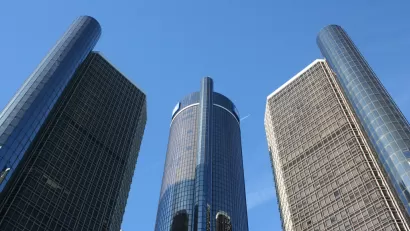The Daily Source of Urban Planning News
Are Apps the Answer to Oakland's Problems?
Azeen Ghorayshi looks at how Oakland's civic hackers are trying to change the city through technology -- giving people greater access to data, increasing transparency, and keeping people better informed -- all with minimal investment by the city.
Impacts of Climate Change More Dire Than Previously Predicted
The draft of a new report issued last week by the U.S. government concludes the impacts of climate change are spreading faster than previously predicted.
Paying by the Mile - Not a Question of "If" but "When and by How Much"
Justin Hyde is firmly in the camp that 'Vehicle-Miles-Traveled' (VMT) fees are coming - and the release of a GAO report last month may support that contention. Privacy concerns from GPS and collection costs are challenges that were considered.

Can Small Mixed-Use Projects Succeed?
Amanda Kerr reports on a trend in small mixed-use developments in southeastern Virginia. Can such projects succeed while larger mixed-use developments in the region struggle?
Could the Bloom be off D.C.'s Boom?
Annie Lowrey looks at how the taxpayer funded expansion of private contracting for the federal government turned D.C. from "national embarrassment" to creative class hot spot, and why those boom days may be coming to an end.
Japan Perfects the Art of Delicate Demolition
John Metcalfe looks at how one Japanese company is advancing a more quieter sensitive method for demolishing high-rise buildings, floor by floor.

Kresge Pledges Additional $120 Million Toward Detroit Revitalization
Detroit has received a significant showing of confidence from its benefactor, The Kresge Foundation (based in Troy, MI) after it unveiled its new strategic plan known as Detroit Future City. As the city downsizes, the challenges are significant.
Reviewing a Smaller Year in Taller Buildings
The Council on Tall Buildings and Urban Habitat has released its annual report on the state of skyscraper construction. Worldwide, 2012 witnessed the completion of 66 buildings taller than 200 meters, including the second tallest in the world.
Marching Towards More Walkable Communities
Richard Florida interviews Jeff Speck about his new and highly praised book "Walkable City." The two authors discuss why cities should become more walkable to meet the needs of the "Walking Generation."
Mapping Chicago's Growing Cornucopia of Urban Gardens
In Chicago, like in many cities, local food production comes in many forms, from small backyard crops to community gardens. Researchers are now using Google Earth to paint a more accurate picture of food production at different scales.

How Art Inspires L.A.'s Public Transit Commuters
As the L.A. metro continues to expand, so do opportunities for artists to showcase their art. For transit riders, this adds an important element to their daily journey, making the commuting experience all the more memorable.
EIR Lawsuits Target Infill Locations
Most California lawsuits challenging environmental impact reports have their sites set on infill projects.
The Demise of Fresh & Easy: What Does It Mean for Food Deserts?
What does the impending demise of the Fresh & Easy grocery chain mean for food deserts? Hannah Burton Laurison and Christine Fry look at how small-format grocery stores can still succeed where Fresh & Easy failed.
How Important is the Neighborhood Effect?
Social scientists have a theory that a neighborhood's character shapes its economic future more than income levels and foreclosure rates. A tragedy to the community of Chatham on Chicago's South Side has tested this "neighborhood effect."
Can Urban Planning Heal the Trauma of War?
To ease the transition from conflict into post-conflict and stability, there is a high need for urban professionals who can artfully balance the demand for security alongside city spaces for healing, argues Mitchell Sutika Sipus.
BLOG POST
Good Urban Parks and Our Wellbeing
Broadening our definition of parks to recognize their role in preventative health care and promotion will only expand our awareness on how important they are to good neighbourhood design.
Friday Flick: Animating Great Architecture
Our friends at the Architect's Newspaper have come across a delightful video that animates the work of 26 of the world's most notable architects, from A to Z, set to a peppy soundtrack.
How Can the UK Revive its Main Streets?
Despite their more traditional, mixed-use development patterns, the UK's town centers are not immune from declining "high streets" as a result of the poor economy, and the attractions of shopping centers and online retail. How can they fight back?

An Astounding Explanation for Why Big Cities Are More Dangerous Than Small Ones
For decades, researchers have hunted for an explanation for why big cities have been more prone to violent crime than small ones. A new hypothesis may offer a surprising answer, and prove that big cities aren't inherently much more dangerous.
In the On-Deck Circle: Atlanta's Next Neighborhood
Four developer teams have pitched competing visions for how to transform 55 acres of parking lots adjacent to Atlanta's baseball stadium into the city's next "hot intown neighborhood." J. Scott Trubey looks at the concepts.
Pagination
City of Camden Redevelopment Agency
City of Astoria
Transportation Research & Education Center (TREC) at Portland State University
City of Camden Redevelopment Agency
Municipality of Princeton (NJ)
Regional Transportation Commission of Southern Nevada
Urban Design for Planners 1: Software Tools
This six-course series explores essential urban design concepts using open source software and equips planners with the tools they need to participate fully in the urban design process.
Planning for Universal Design
Learn the tools for implementing Universal Design in planning regulations.


































